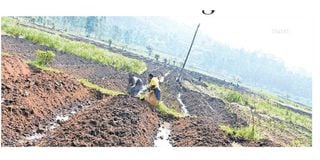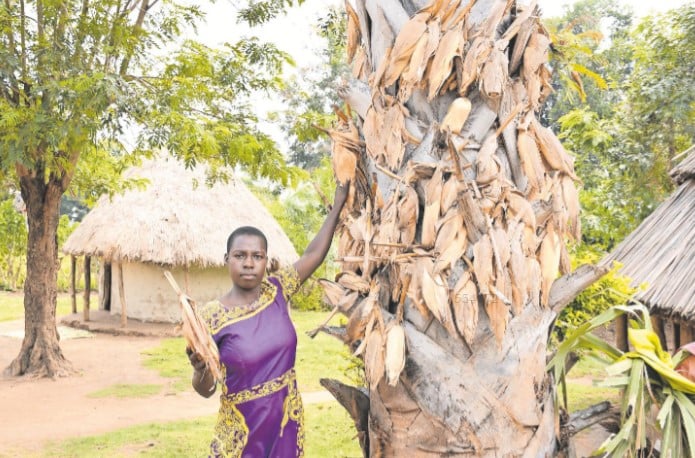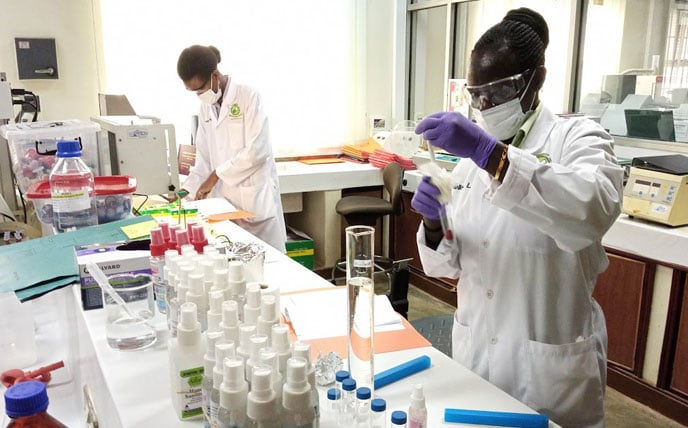Kigezi sub-region grapples with climate change effects

Farmers expose peat, an accumulation of partially decayed vegetation or organic matter, as they prepare their gardens in Bubare Wetland in Rubanda District. PHOTOS/ ROBERT MUHEREZA/FILE
What you need to know:
- The current unpredictable rains and droughts in the sub-region have caused a significant impact on soil nutrients, affecting the agricultural productivity.
When the then British Deputy Secretary of State for Colonies, Mr Winston Churchill, visited Uganda in 1907, he named Kigezi Sub-region the Switzerland of Africa because of its cold weather and interlocking hills that displayed a beautiful scenery.
However, the status has since changed because of human activities and population growth.
The Kabale District Natural Resources Officer, Mr Henry Tumwesigye, says in the last 10 years, his district has lost 60 percent of the wetlands to human activities that include urbanisation, and crop and dairy farming.
“In the last 10 years, day temperature has increased from 12 degrees Celsius to between 15 and 23 degrees Celsius currently. This is an indicator that our natural resources such as wetlands and forest cover have been degraded because of human activities and population growth,” he says.
Mr Tumwesigye adds that air pollution from several mining activities in the sub-region and degradation of wetlands have increased ozone layer-depleting gases, thus leading to increased temperatures during day and night time.
He also adds that the increased need for biomass fuels such as charcoal and firewood has also led to climate change because most of the forests that are supposed to consume carbon-related gases and provide oxygen for human life have been degraded without replacement.
“Some of the interventions being put in place to reverse the trend include the implementation of the presidential directives on wetland restoration, encouraging farmers to embrace climate-smart agricultural practices and promoting energy-saving technologies that reduce pressure on the forest cover,” Mr Tumwesigye says.
He adds that Kabale District has introduced an ordinance on soil, water biodiversity and solid waste management to reduce environmental degradation risks.
“We have also formulated a district forestry development plan for massive planting of indigenous trees and bamboo. We are also developing a 10-year district environmental plan detailing the role of each sub-county/town council in restoring the degraded environment in their localities,” Mr Tumwesigye adds.
Disease outbreak
The Kabale District Health Officer, Dr Gilbert Mateeka, says climate change has resulted in disease outbreaks, especially malaria, which was not common in the area when the temperatures were low and the weather was generally cold.
“Environmental degradation is responsible for the rampant cases of malaria because the current warn weather conditions favour the multiplication of mosquitoes. The outbreak of diseases like Mpox and Marburg is an indicator that human activities have invaded the habitat of the wildlife,” Dr Mateeka says.
Mr Achilles Byaruhanga, the executive director of Nature Uganda, a conservation organisation, says climate change has led to unpredictable prolonged rains and drought seasons that are destructive to human life, property and the environment.
“Having a dry season from May to October, as it is the case today, has never been had in Kigezi Sub-region because, in the past, the dry season in the area used to begin at the end of May up to about mid-August,” Mr Byaruhanga says.
“But now it is October and we have not had good rains. This trend may soon be experienced in the whole country because of the extremes that are affecting the agriculture systems that are always dependent on natural rains because of erratic weather patterns the result will be poor crop production and food insecurity,” he adds.
Mr Byaruhanga says Kabale is now no longer a food basket.“Kabale used to be the source of food but now people have to buy food from other districts; that is how climate change and weather patterns have affected the local people in the area,” he explains.

The UPDF soldiers conduct an operation against illegal charcoal trade.
The area used to be cold because of the modulation of local micro climate factors such as abundant wetlands, papyrus in valleys, forests and grass lands.
“This micro-climate has been tempered with and almost all the hills are bare because forests and vegetation cover were destroyed, except the protected ones in Echuya and Mafuga forest reserves, and Bwindi and Mgahinga national parks. These remaining forests cannot moderate the climate in the area,” Mr Byaruhanga says.
He argues that the consequence of prolonged rains is that soils are swept from the hills to the valleys, destroying properties and killing people.
Pests
Another consequence is that the crops have been attacked by pests and diseases because the insects that could not survive in the then cold weather in the area are now rampant due to the warm weather.
“Previously, we never used sprays on our crops but now farmers must spray every crop to kill pests in order to have better harvests. With Irish potatoes, it is worse, because farmers must apply chemicals during planting up to harvesting and post harvesting. All these are indicators of effects of climate change,” Mr Byaruhanga adds.
He emphasises the need for protecting the micro-climate factors to reduce floods, soil erosion and landslides.
He adds the destroyed terraces must be restored and government programmes geared towards the restoration of wetlands must be fully implemented.
“It is estimated that the biggest emissions of carbon for Uganda is not from factories but from peat in the degradation of wetlands and the claim that carbon emissions are from the developed countries no longer holds because Uganda is contributing a lot of carbon emissions because of draining wetlands,” Mr Byaruhanga explains.
“We did a study in Nyamuriro wetland and other wetlands around Lake Bunyonyi and we found out that they had a lot of deposits of peat in Uganda and these are the same wetlands that have been degraded,” he adds.
He says Nature Uganda played a critical role in saving Echuya Forest that was most degraded in 1998 yet it was the most important source of water for Lake Bunyonyi, Kisoro, Rubanda and Kabale districts.
He also reveals that through research, they have established that Echuya forest, which used to be a bamboo forest, now has other tree species because of climate change that does not favour the multiplication of bamboo trees.
ABOUT KIGEZI
Popularly known as the Switzerland of Africa, Kigezi includes districts such as Kabale, Rukiga, Rubanda, Kanungu, Kisoro and Rukungiri in south-western Uganda. The region is uniquely characterised by the Western Rift Valley, and the African Great Lakes, which include Lake Bunyonyi, Lake Edward and Lake Kyahafi. Kigezi also hosts the Mgahinga Gorilla National Park which, along with the nearby Bwindi Impenetrable National Park are home to the internati
DISEASES
Outbreaks
The Kabale District health officer, Dr Gilbert Mateeka, said climate change has resulted into disease outbreak ‘‘Environmental degradation is responsible for the rampant cases of malaria because the current warn weather conditions favour the multiplication of mosquitoes. The outbreak of diseases like Mpox and Marburg is an indicator that human activities have invaded the habitat of the wildlife.’’




